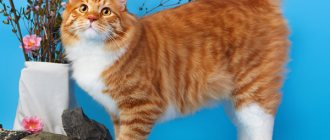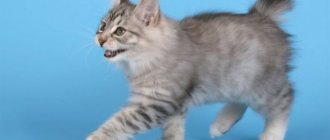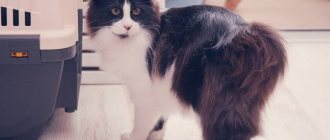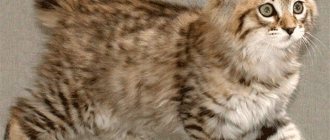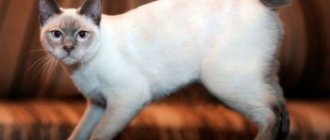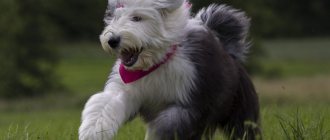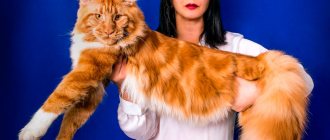The Kurilian Bobtail is an interesting representative of the cat family. Due to its size and habits, it has taken root well in rural areas. It’s difficult to call her sweet and gentle; many of her character traits suggest that she is a dog in cat’s clothing. You shouldn’t make a fuss towards the bobtail; you’ll be ignored – call him by name.
Such habits are sure to endear dog lovers who do not like the amount of attention that a dog usually needs. Of course, a cat can be raised to be affectionate and gentle, but it is difficult to perceive the Kuril Bobtail as a sissy.
The Soviet Union is considered the birthplace of the breed - it was thanks to Soviet felinologists that the cat came to the mainland and received recognition. At the same time, there is reason to believe that the breed is more than 200 years old, and it originated, then, on the Japanese islands.
History of the Kurilian Bobtail breed
The Kuril Islands (namely the southern part of the archipelago) are a stumbling block between two powers: Japan and Russia.
The ownership of these lands was repeatedly disputed until the Kuril Islands came under the wing of the Russian Federation. Along with the territory, the state also secured the right to be considered the homeland of one of the most remarkable and unique breeds in the world. According to the point of view of most felinologists, Kuril bobtails descended from short-tailed cats that inhabited the archipelago at least since the 18th century. Their ancestors were presumably wild and were the result of a union between Japanese Bobtails and Siberian cats. The history of the appearance of these breeds on the Kuril Islands is no less interesting.
Ancient beliefs of the Land of the Rising Sun say that Japanese bobtails were considered a symbol of good luck and therefore were overly patronized by local residents. In addition, these animals had a sacred origin: their ancestors were considered to be the white temple cats that guarded the shrines of the Buddha's followers. Some bobtails came to the archipelago with the Japanese as part of research or military expeditions. They were often used as guards on imperial farms where fur-bearing animals were bred. Obeying instincts and wanting to escape from the “golden cage”, many cats escaped into the wild. After several generations, Japanese bobtails acquired new features, trying to adapt to harsh living conditions: the fear of water disappeared, the claws stopped retracting into the paw pads, and their owners became larger in size.
As for Siberian cats, they came to the Kuril Islands along with settlers. The animals easily made friends with the feral “Japanese”, and as a result of this union a new breed arose, now known as the Kuril Bobtail.
It is worth noting that the selection of these animals did not begin immediately. Despite the relatively long-standing appearance of the breed, felinologists paid attention to it only at the end of the 20th century. Up until this point, breeders visited the Kuril Islands and left with bobtails, mistaking them for their Japanese counterparts. Back then, no one imagined that charming short-tailed creatures were something new in the already rich cat world. However, since 1991 everything has changed.
It was then that new representatives of the breed were brought from the Kuril Islands. In October, the first standard of the Kuril Bobtail was adopted, and the Soviet Felinological Organization (SFO) played an important role in this. Tatyana Bocharova, observing the selection of cats, came to the conclusion that a short tail is inherited by all animals, which meant the absence of any anomalies in their development. Having registered the “Kurilians” as an independent breed, the Siberian Federal District has set itself a new task - to achieve similar recognition among European felinologists.
December 1994 was marked by a seminar at which Russian breeders put forward a proposal to refine the standard of the Kuril Bobtail breed with a view to its recognition by the international organization WCF. The official registration of short-tailed cats took place only a year later, which provoked a sudden outbreak of European interest in the unusual breed. Increasingly, cat shows began to be held in Italy, Germany, Poland and the Czech Republic, with Kurilian bobtails being frequent guests. By that time, nurseries had already appeared that specialized in breeding two varieties of the breed: long-haired and short-haired. At the same time, the first category was divided into individuals with long and semi-long coats.
In 2001, the felinological association of CIS clubs further clarified the standard at a coordination meeting, but it remained unchanged. This prompted the felinological organization FIFe to officially register the breed three years after this event. In 2012, the Kurilian Bobtail firmly established itself in the lists of the American TICA association.
The mid-90s became a turning point in the fate of representatives of the breed. From 1995 to this day, Kurilian bobtails have been “capturing” more and more territories, winning the hearts of people. These cats are valued in many European countries for their gentleness and good nature, but in their historical homeland, bobtails are popular mainly among hunters and fishermen - largely due to the excellent instincts of the animals. However, this breed is still not as popular as the beloved British, Persian or Siamese cats.
Appearance of the Kurilian Bobtail
Representatives of the breed have a very contrasting appearance. The squat stature hides developed and strong muscles, which allow animals to make huge jumps. Kurilian bobtails are distinguished by a high degree of sexual dimorphism: males are several times larger than males. So, their mass is 7.5 and 4-5 kg, respectively.
The Kurilian Bobtail is a medium-sized breed. The heritage of wild ancestors can be equally traced in the appearance of individuals of both categories of the breed - long-haired and short-haired.
Head and skull
The head has the shape of an equilateral triangle, the outlines of which are softly rounded (this is especially visible when the animal stands in profile). In adult bobtails, it looks more like a trapezoid, and this is due to the cheeks with defined and full “pads” for the whiskers. The skull is flat.
Muzzle
The Kurilian Bobtail has a rather wide and rounded muzzle. The stop is indicated only formally and is practically not noticeable. The flat forehead goes into a straight and wide nose of medium length. His lobe is well defined. The strong chin is developed and has smooth outlines, noticeable in profile. The animal's cheekbones are not as low as those of their Siberian counterparts.
Ears
Medium-sized triangles are set high and quite wide. In this case, the distance between them corresponds to the width of the base of the ear, but in no case can it be less. The tips are softly rounded. Long-haired Kuril Bobtails wear a “decoration” on them in the form of small tassels, giving the animals an even greater resemblance to a lynx.
Eyes
They are shaped like a nut: oval at the top and slightly rounded at the bottom. They are notable for the fact that they are slanted in an oriental manner, and this gives the animal’s look an exquisite mystery. The eyes are set quite wide and “lie” on a line that runs from the nose to the base of the ears. The pigmentation of the iris is predominantly yellow or green; In two-colored and white animals, blue is found. In general, the standard also provides for a discrepancy between the eye color and the color of the bobtail.
Jaws and teeth
The presence of strong jaws is due to the lifestyle of the feral ancestors of the breed. Existing in the wild, cats were forced to get their own food. Pincer bite; complete dental formula. It consists of incisors, canines, premolars and molars.
Neck
Not long enough, strong muscles can be felt under thin skin. Due to the thick coat, she appears plump.
Frame
The Kurilian Bobtail has a dense and strong body, which at any moment is ready to demonstrate flexibility unexpected for an animal. Muscles do not burden the appearance of the cat. The body has an elongated shape. The chest is developed, the back line has an arched bend. The animal's croup is slightly raised.
Tail
The Kurilian Bobtail is notable for its short and slightly curved tail, which rises above the line of the back. Its length varies between 3-8 cm, but in long-haired individuals it can reach 13 cm. There are four types of animal tail.
- The “stump” consists of deformed vertebrae (no more than eight) firmly connected to each other. It can be straight or slightly curved down like a hook.
- The “spiral” includes 5-10 vertebrae. This type of tail is one of the most characteristic of the breed.
- The “panicle” consists of the same number of vertebrae as the “spiral”. It has a straight shape, one-third the length of a regular tail.
- The "retracted bobtail" includes 5-7 vertebrae, the line of which twists into an improvised loop near the end of the tail. Considered a breed defect.
The shape of the pompom is not regulated by the standard. His grooming is acceptable and even preferable.
Limbs
The hind limbs of the bobtail are not much longer than the front ones. Rendered muscles are the main reason for the phenomenal jumping ability of animals. Compact paws have a rounded shape, the toes are tightly clenched. The claws do not retract and when in contact with the surface they make a clicking sound, more characteristic of dogs than of cats.
Coat
The type of coat of a “Kurilets” depends on its belonging to a certain type of breed.
- The shorthaired bobtail has fine, short hair. It is permissible to increase its length on the tail, as well as on the back and lower sides of the animal’s body.
- The long-haired bobtail, as the name suggests, has long or medium-length hair. As with its short-haired counterpart, this Kurilian Bobtail has longer hair on the underside and rear of the body. In addition, he is notable for his “collar”, “pants” and lynx tassels on the tips of his ears.
Both varieties of the breed have a thick undercoat.
Color
The Kurilian Bobtail is notable for the fact that its color can be almost anything. The most common options are smoky, tabby (tabby), bi- and tricolor. The breed standard does not recognize Burmesse, Abyssinian, lilac and chocolate colors.
Possible defects
Among the defects of the Kuril Bobtail breed are:
- forelimbs of insufficient length;
- deep-set and/or bulging eyes;
- excessively short or long tail;
- pronounced bend of the back line;
- pointed tips of the ears;
- high set cheekbones;
- lack of undercoat;
- elongated body;
- narrowed head.
Disqualifying defects include:
- short tail without bends or kinks;
- tail exceeding 13 cm in length;
- undescended testicles;
- erosion of the mucous membrane in the anal area;
- spinal deformity;
- amputated claws;
- absence of a tail;
- deafness.
Character of the Kurilian Bobtail
In contrast to the external resemblance to a wild and unapproachable lynx, representatives of the breed are distinguished by genuine friendliness and affability. This significantly speeds up the bond between cats and new owners. The Kurilian Bobtail will not sit, frowning, under the chest of drawers and snort irritably in response to your attempts to get it out of its temporary hiding place. On the contrary: these animals love to communicate and actively get involved in joint games with family members. “Kurilians” are often called dogs in a cat’s body, since they happily bring toys and balls thrown by the deft hand of the owner.
By the way, the Kuril Bobtail develops a very tender relationship with its family. For representatives of this breed, there is nothing more important than loved ones who give them sincere love and care. The animal will protect the family in which it lives exclusively “like a dog”: taking a menacing stance and meowing in warning. At the same time, the bobtail will especially take care of one person, whom he considers his master. If you managed to occupy this honorable pedestal in the furry guard’s heart, the pet will follow on your heels, communicating in its own language and taking all possible part in your life.
Kurilian Bobtails are ideal for families with children. An animal will never intentionally scratch a baby, but, on the contrary, will bestow excessive “mustached” care on him. The “Kurilets” will not show aggression even if a child accidentally pulls its tail or ear. Instead of hissing and being offended all day long, a bobtail will happily involve your child in a game of hide and seek or demonstrate a recently learned trick that will certainly cause sincere children's laughter.
Representatives of the breed get along well with other pets. Cat or dog – it doesn’t matter: the Kurilian Bobtail will find a common language with both the serious Maine Coon and the playful Dachshund. However, it is strictly not recommended to keep ornamental birds and rodents in the same house as a bobtail. A hunting instinct that awakens at the wrong time can turn into a tragedy, and your attachment to an animal can turn into grief for a lost feathered or furry friend.
Along with being meek and good-natured, this breed is distinguished by its willful and independent character - this is what many owners of Kuril Bobtails say. Animals do not like to sit in your arms for a long time, pretending to be a plush toy, and will soon try to leave the heated place. In the absence of proper attention from the owner, the “smokers” begin to live by their own rules and soon consider themselves the rightful owners of the territory, namely your apartments. At the same time, overthrowing the short-tailed usurper will not be easy. Even the slightest glimmer of success will soon turn into defeat for you: the pet will begin to protest. Damaged things, torn blinds or curtains, an overturned sugar bowl - and the Kurilian Bobtail’s vendetta will not be limited to this.
Do you think that your pet is overly lazy and less and less involved in games? Take a day off from work and go with your animal to the country, where it will appear before you in a completely different form. A dexterous hunter will in the blink of an eye displace the domestic bumpkin from the Kuril Bobtail. In the fresh air, representatives of the breed are especially active: they track prey for several hours without closing their eyes; fight with neighbor cats for free territory; they poke their curious nose into every remote corner of the house, emitting a purring sound reminiscent of bird trills.
Education and training
Kurilian bobtails have developed intelligence, which allows animals to understand the meaning of over a thousand words! Raising a pet is not difficult: the main thing is to correctly determine the boundaries of what is acceptable. You should not raise your hand to the cat, because there are other ways to tell your pet about your dissatisfaction. A stern tone is quite enough. This tactic also works if you want to stop your bobtail from acting inappropriately. The word “no” will certainly prevent unwanted consequences.
If your pet has escaped your close attention and misbehaved, have an educational conversation as soon as possible. Otherwise, the bobtail will not understand what exactly he has done wrong.
Upon reaching a certain age, “smokers” begin to test the owner’s strength, making attempts to take a leading position in the house. At this stage of education, you will need to be able to adequately respond to the animal’s behavior and make it clear that you do not plan to cede dominance to your wayward furry friend.
Otherwise, raising Kurilian Bobtails is not difficult, especially for people with a strong character. Teaching your pets to use the tray and scratching post for their intended purpose is also not difficult.
Representatives of this breed are easy to train. Their inquisitive mind allows them to learn new tricks and adopt the skills of their tailed brothers. Turn the training process into an exciting game - and soon your bobtail will delight you with brilliant execution of commands!
Care and maintenance
The Kurilian Bobtail does not require careful grooming - and this is another plus in favor of the breed. Even long-haired bobtails do not cause unnecessary inconvenience to their owners.
Since the undercoat of cats is moderately developed, the coat almost never gets tangled, and the procedure of combing the Kuril Bobtail does not become a daily chore. Once or twice a week is enough. It is recommended to purchase a special brush with metal teeth or a glove with silicone growths to remove dead hair. When combing, follow the direction of hair growth.
Bathing for bobtails is one of the most favorite ways to spend time, but you should not overuse it: the skin becomes dry and the guard hair becomes thinner. Using special mild shampoos and conditioners will not help the situation. You should only bathe your pet if it is dirty. Fill a bowl or sink with warm water and then place the cat there. Apply shampoo to the coat, carefully distribute it over the entire body of the Kurilian Bobtail and rinse. After bathing procedures, the pet must be thoroughly dried. For short-haired cats, a towel cocoon is perfect, but long-haired cats will need a hairdryer.
From their ancestors, Kurilian Bobtails inherited the inability to fully retract their claws. For this reason, they are perfectly worn down both while the pet walks and when it interacts with the scratching post. However, it still doesn’t hurt to get a special device for shortening them. Cut off only the ends, otherwise you will damage the thin vessels.
Don't ignore your pet's eyes. They need to be washed several times a week, using a piece of clean, lint-free cloth or cotton wool soaked in a special product (this can be purchased at a pet store). When rubbing your eyes, move your hand from their outer corner to the inner one. The bobtail's ears should be inspected with a similar frequency, wiping them with a cotton pad soaked in a special lotion. Otherwise, wax will accumulate in the ears, which can later lead to the development of infectious diseases.
When it comes to oral care, brushing your cat's teeth once a week is sufficient. However, the use of “human” pastes is strictly prohibited. Get a special attachment for your finger to make the procedure much easier. Don't forget that if absolutely necessary, you can use a regular toothbrush.
Representatives of this breed are extremely unpretentious eaters, but this does not mean that you can feed your pet table scraps. For a show-class Kurilian Bobtail that regularly participates in exhibitions, it is best to purchase premium food. For breed and pet animals, regular food combined with natural food, in particular boiled meat, is suitable.
The following should not be included in the Kuril Bobtail diet:
- some vegetables: potatoes, legumes, eggplants;
- fish (with the exception of low-fat sea fish);
- raw and fried meat;
- bakery products;
- dairy products;
- pork and lamb;
- tubular bones;
- smoked meats;
- sweets.
There should always be filtered fresh water in your pet's bowl.
Feeding pets
Bobtails are very sensitive to the quality of food, both natural and ready-made. Breeders recommend a natural diet for bobtails with a sufficient amount of meat and sea fish. Let's list the natural products that are required and prohibited on the short-tailed fish menu:
| Can | It is forbidden |
| Raw frozen beef, boiled boneless chicken. Boiled low-fat sea fish. No bones. Chicken or beef by-products - hearts, lungs, liver, kidneys, raw or boiled. Raw or boiled egg yolk, pure or grind with kefir, add to porridge. Fermented milk products: sour cream, kefir, fermented baked milk, yogurt, cream - all medium fat, without sugar or additives. Fresh, non-acidic cottage cheese can be mixed with sour cream or raw egg yolk. Cereals: rice, buckwheat, steamed oat flakes, wheat groats. Boiled cereals are mixed in a 1:2 ratio with boiled meat or boiled fish. Vegetables, raw or boiled: carrots, cauliflower and others. Mix in a 1:2 ratio with boiled meat or boiled fish. Greens, sprouted wheat grains, special grass for cats. | Food from the human table. Salted, fried, smoked food. Pork, lamb, goose, duck. River fish, seafood. By-products – spleen, chicken necks and bones. Egg white. Butter, salted cheese. Citruses, kiwi, pineapple, persimmon. Nuts and beans. Potatoes, onions, garlic, tomatoes, eggplants, mushrooms. Confectionery. Bread and other baked goods. Tea coffee. Alcohol. |
The peculiarity of the intestines does not allow bobtails to consume dairy products and potatoes.
The proportion of proteins, fats and carbohydrates should be as follows - 60-70% protein, 10% fat, 20-30% carbohydrates. It is best to check with your veterinarian for serving size.
Ready-made foods are also suitable for bobtails, but they should be premium foods, since cheaper ones cannot always sufficiently provide the animal’s body with nutrients. The serving size must correspond to the standards indicated on the packaging.
Health and disease of the Kurilian Bobtail
From their Siberian ancestors, cats inherited good health, which rarely causes unnecessary trouble for their owners. There are no specific or genetic diseases observed in this breed, but certain diseases are still common among Kuril Bobtails. Among them:
- cracks and inflammation of the anal mucosa;
- rectal prolapse;
- urolithiasis disease;
- haemorrhoids.
The excellent immunity of animals does not exclude the possibility of developing infectious and parasitic diseases. Regular vaccinations and visits to the veterinary clinic are a guarantee of the health and longevity of your pet.
Weight table by month
The weight of an adult Kuril Bobtail reaches 4-7 kg, in cats - 5-9 kg.
| Age | Cat | Cat |
| 1 month | 280-400 gr | 330-460 gr |
| 2 | 550-750 gr | 880-1.2 kg |
| 3 | 1-1.2 kg | 1.1-2.2 kg |
| 4 | 1.3-2.4 kg | 1.8-3.2 |
| 5 | 1.7-2.7 kg | 2.6-3.6 |
| 6 | 2.6-3.4 kg | 3-4.4 kg |
| 8 | 3-4.1 kg | 4-5.2 kg |
| 10 | 3.2-4.4 kg | 4.4-5.8 kg |
| 1 year | 3.5-5 kg | 5-6.8 kg |
| 2 | 3.8-6 kg | 5.4-6.6 kg |
How to choose a kitten
Purchasing a Kurilian Bobtail kitten is a responsible step that requires intuition and attentiveness from you! It is important to notice among the frolicking kittens exactly the one who will catch your heart. At the same time, you should not listen to either the words of the breeder or the advice of friends and relatives: this is your pet, so you only need to rely on your own premonitions.
The ideal age for purchasing a Kurilian Bobtail is three months. It is at this time that the baby begins to show independence and gradually weanses the habit of maternal care. In addition, a three-month-old “smoker” already has fairly balanced psychological health, so he quickly gets used to new family members.
If the pedigree of the future pet plays an important role, ask the breeder to introduce you to the necessary documentation or, more preferably, to the parents of the babies. This is one of the easiest ways to understand what to expect from your bobtail. The breeder is not talkative and does not demonstrate a desire to tell as much as possible about his charges? This is an alarming sign: it means he has something to hide from curious and persistent buyers like you.
When choosing a kitten, you should focus on its behavior among its brothers. Is your baby active and cheerful, happily getting involved in play and showing healthy curiosity towards you? This is your pet! Refrain from buying lethargic and timid kittens: this may lead to unpleasant consequences in the future.
Key facts
The main characteristic of the Kurilian Bobtail is its tail. Outwardly, it resembles a fur ball. This trait was inherited by the breed from its Japanese neighbors.
Despite the fact that cats are proud creatures by nature, they are seriously attached to the family in which they live, but they can only have one owner. Do not pay attention to the similarity of these cats with wild predators. They are friendly and playful by nature.
Bobtails will only be welcome for children in the house. Don't want your child to be bored alone? The Kurilian Bobtail cat will take part in any game. Bobtails also treat other pets leniently, however, given their cat-like nature, you should still not let ornamental birds or rodents get close to them.
Be prepared for the fact that from time to time the bobtail will test your nerves and show excessive nobility and willfulness. Do not succumb to the furry's provocations, otherwise he will lose respect for you. The description of the Kuril Bobtail breed explains its dominance by the conditions in which the breed was bred.
The health and life expectancy of the Kuril Bobtail are encouraging: seals live up to 15 years, and there are also those individuals that have reached the 17-18 year mark.
How much does a Kurilian Bobtail cost?
As with other breeds, the ideal place to purchase a Kurilian Bobtail is in nurseries that specialize in breeding this breed. The price of an adorable baby starts from 8,000 rubles; the upper limit is limited to 20,000 - 25,000 rubles. In general, the cost of a bobtail is determined by the prestige of the nursery, the presence of a noble pedigree and the class of the kitten (show, breed or pet).
It is worth noting that this breed also has a fourth class - “novice”. It consists of individuals brought directly from the Kuril Islands. The origin of these animals is unknown, but if it is not important for you to become the owner of a pet with noble ancestors, go for it! In any case, the Kurilian Bobtail will become a devoted friend and companion.
Kittens
Adopting a Karelian Bobtail kitten is incredibly difficult, since this species is very rare. Therefore, the choice of a little friend must be approached with the utmost seriousness. Before purchasing, it is best to visit exhibitions and talk to breeders.
Find out all the information about parents, diseases, living conditions and nutrition. It is also recommended to examine all kittens born in the litter. All animals must be well-groomed and active.
When choosing a pet, you need to pay attention to the following criteria:
- Ears, eyes and nose without discharge;
- The skin under the fur is free of redness, rashes and wounds;
- The mucous cavities have a uniform pink color;
- The animal is not thin, the belly is round, but not bloated;
- The anus is clean and without cracks.
After purchasing the kitten, the breeder must provide the following documents:
- Passport confirming the breed;
- Veterinary card with vaccinations.
But if a breeder offers to buy a bobtail kitten with a share, it means that this is a deception, since the cat receives a pedigree only after the first independent exhibition.
The price of a Karelian bobtail baby ranges from 15 thousand rubles. — 40 thousand rubles. Such a large range depends on what the Karelian is purchased for, so if you want to acquire a champion, you will have to pay a fairly large amount for the purchase.
